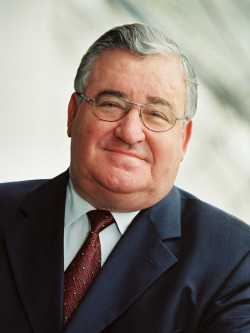SIGGRAPH 1995 Steven Anson Coons Award: Encarnação
Awardee(s):
Award:
- Steven Anson Coons Award
Description:
The 1995 Steven A. Coons Award is presented to Dr. Jose Luis Encarnação for leadership in applied research using computer graphics for a broad range of industrial and medical applications, in international graphics standards and in computer graphics education.
His work in computer graphics began at the Technical University of Berlin in 1967 when he was also associated with the Heinrich Hertz Institute. In the period 1972-75 he was at the University of Saarbrucken. In 1975 he became Professor at the Technical University of Darmstadt, an appointment he holds today.
His earliest work involved development of basic algorithms such as hidden-line elimination and hardware for matrix manipulations (4 by 4). Encarnação Scan-Grid Hidden Surface algorithm was particularly appropriate for surface representations used in CAD applications for car body design. It was during this period he became concerned with graphics systems applied to computer aided design-early evidence of his long-term commitment to technology transfer between academia and industry, a hallmark of the German and European technical communities.
His efforts in standards were consistent with that commitment. Starting in 1970, Encarnação lead successful efforts at Standardization in Computer Graphics in Germany. He convened experts from all over Germany and involved many from the group of researchers he had assembled in Darmstadt. He has been especially active in DIN and ISO standards, and was a primary contributor to the GKS graphics standard. He participated in the celebrated meetings at the Chateau Seillac in 1976 that led to the Proposed Core Standard put forth by SIGGRAPH. Recognizing at that time the need for a practical 2D system, he spearheaded the effort to produce the Graphical Kernel System, GKS, an extensive elaboration of an early version of the 3D Core proposals. Subsequently, under Encarnação’s direction, Gunter Pfaff et al developed a GKS implementation at Darmstadt that became the leading commercial product of its kind and remains in use in German CAD and other graphics application systems.
As a professor specializing in computer graphics for more than twenty years, Dr. Encarnação had been the advisor for more than forty Ph.D. students, many of whom have themselves attained professorial positions. To ensure the stability of Computer Graphics in academic computer science and in industry he initially established the Interactive Graphics Research Group (THD-GRIS) in 1975 at the Technical University of Darmstadt. In 1984 he also founded, and became chairman of the board, of the Computer Graphics Center (ZGDV). In addition to the main laboratory in Darmstadt, it now has associated laboratories in Rostock and in Portugal. In 1987 he became the director of the Fraunhofer Institute for Computer Graphics in Darmstadt. At the request of the government, he aided in the re-unification task by establishing a Fraunhofer Graphics Laboratory in Rostock. These institutes are staffed by computer graphics-professionals, more than a hundred in Darmstadt alone, and provide a home for many more students pursuing study and research in computer graphics and its applications.
An early example of successful technology transfer accomplished by these important and valued institutes is the GRADAS system developed in 1975 for AEG. The GRADAS systems was used by the Deutsche Bundespost for more than 15 years for interactive archiving, handling and editing of communications (telephone) drawings. A more recent example is the TRITON system developed for the Deutsche Wetterdienst (weather bureau) for visualizing and presenting weather forecast on TV and now in use by six European TV-channels. The latest contribution is an ISDN-based medical teleconsultation system, KAMEDIN, now being very successfully deployed by the German Telekom.
In 1980 Encarnação was the driving force behind founding EUROGRAPHICS, the eminent forum for graphics researchers and practitioners in the greater European community. Not only did he spearhead its formation, but he devoted considerable energy as its first chairman to sustaining it through its early and formative years.
He was the author of more than one hundred journal articles as well as eight text books. In particular, his book on computer aided design was one of the earliest to apply a systems approach for describing CAD. It was translated into four languages. Revised and extended in a second edition, it remains one of the few books that presents a coherent and unified approach to a theoretical underpinning for computer aided design.
Encarnação served on several editorial boards, including Computer Graphics and Applications, The Visual Computer, and Computer-Aided Design, and is Editor-in-Chief of Computers & Graphics.
There are many ways Dr. Encarnação inspired and influenced both the German and broader European computer graphics communities. He worked effectively to infuse computer graphics into the international community, forging ties with universities, institutes and industry around the world, including Brazil, China, Japan, Mexico, Portugal, Spain, and the USA. He has received prizes and been awarded honorary degrees in recognition of these achievements.
Dr. Encarnação was a tireless worker and supporter of computer graphics both as a key enabling technology and as a critical academic discipline within the field of computer science. His vision, insight, and energies successfully sustained his devotion to academic excellence while providing critical liaison with industrial and standardization efforts. In recognition of these accomplishments and contributions to Computer Graphics, SIGGRAPH is pleased to present Dr. Jose Luis Encarnação the Steven Anson Coons Award.
Source:
- ACM SIGGRAPH Citation




